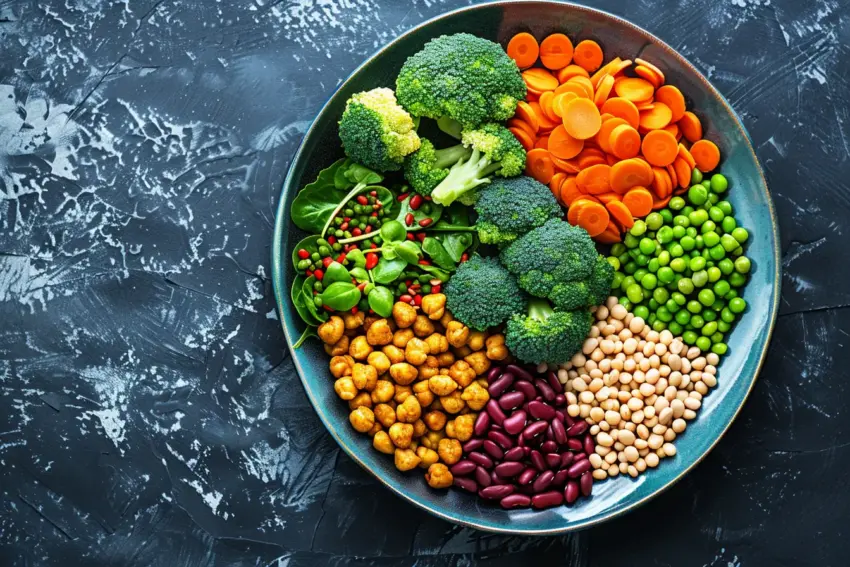- Understanding Veganism: A Beginner's Guide
- Essential Nutrients for New Vegans
- Fruits and Vegetables: The Foundation of a Vegan Diet
- Whole Grains and Legumes: Key Sources of Protein
- Dairy Alternatives: Milk, Cheese, and Yogurt
- Meat Substitutes: Plant-Based Proteins
- Snacks and Convenience Foods for New Vegans
- Building a Balanced Vegan Food List for Beginners
Understanding Veganism: A Beginner’s Guide
What is Veganism?
Veganism is a lifestyle and dietary choice that excludes all animal products. This means avoiding meat, dairy, eggs, and other animal-derived substances like honey. Instead, vegans focus on plant-based foods, including fruits, vegetables, grains, nuts, seeds, and legumes.
Reasons to Go Vegan
Ethical Reasons
Many people choose veganism to avoid contributing to animal cruelty and exploitation. Factory farming practices often involve significant suffering for animals, and vegans seek to minimize this harm.
Environmental Reasons
Animal agriculture contributes to environmental issues like deforestation, water pollution, and greenhouse gas emissions. A vegan diet can reduce your carbon footprint and help protect the planet.
Health Reasons
A well-planned vegan diet can offer numerous health benefits, including lower risks of heart disease, high blood pressure, type 2 diabetes, and certain cancers. Plant-based diets are typically rich in essential nutrients, fiber, and antioxidants.
Transitioning to a Vegan Diet
Start Gradually
It’s often helpful for beginners to transition slowly. Incorporate more plant-based meals into your diet and gradually eliminate animal products.
Educate Yourself
Understanding the basics of vegan nutrition is crucial. Learn about essential nutrients and how to get them from plant-based sources. This will help ensure you maintain a balanced and healthy diet.
Seek Support
Joining vegan communities, both online and offline, can provide valuable support and resources. Sharing experiences and tips with others can make the transition smoother and more enjoyable.
Common Misconceptions
Protein Deficiency
One common myth is that vegans can’t get enough protein. However, there are plenty of plant-based protein sources, such as beans, lentils, tofu, tempeh, and quinoa.
Limited Food Choices
Another misconception is that veganism limits your food options. On the contrary, a vegan diet can be diverse and delicious, offering various culinary experiences from different cultures.
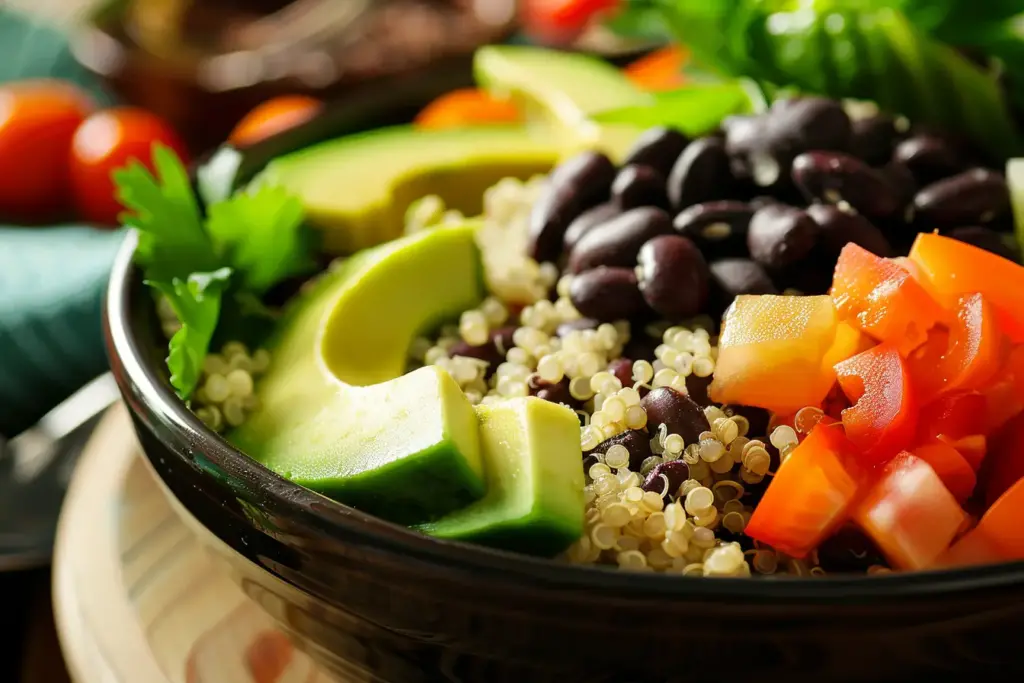
Essential Nutrients for New Vegans
Importance of a Balanced Diet
A well-rounded vegan food list for beginners must include all essential nutrients to maintain good health. Understanding where to get these nutrients is crucial for successfully transitioning to a vegan lifestyle.
Protein
Plant-Based Protein Sources
Protein is vital for muscle repair and growth. Contrary to popular belief, it’s possible to meet your protein needs on a vegan diet. Excellent sources include:
- Legumes: Beans, lentils, chickpeas
- Tofu and Tempeh: Soy-based products
- Quinoa and Buckwheat: Complete proteins
- Nuts and Seeds: Almonds, chia seeds, hemp seeds
Iron
Enhancing Iron Absorption
Iron is essential for oxygen transport in the blood. Plant-based iron (non-heme iron) is less readily absorbed by the body compared to animal-based iron (heme iron). To enhance iron absorption:
- Include Vitamin C-Rich Foods: Pair iron-rich foods with vitamin C sources like citrus fruits, bell peppers, and strawberries.
- Iron-Rich Foods: Spinach, lentils, chickpeas, fortified cereals, pumpkin seeds
Calcium
Non-Dairy Calcium Sources
Calcium is crucial for bone health. While dairy is a common source, many plant-based options are rich in calcium:
- Leafy Greens: Kale, collard greens, bok choy
- Fortified Plant Milks and Juices: Almond milk, soy milk, orange juice
- Tofu: Made with calcium sulfate
- Almonds: A handful a day
Vitamin B12
Importance and Sources
Vitamin B12 is essential for nerve function, DNA, and red blood cell production. Since it’s primarily found in animal products, vegans need to find alternative sources:
- Fortified Foods: Nutritional yeast, plant-based milks, breakfast cereals
- Supplements: Consider taking a B12 supplement to ensure adequate intake
Omega-3 Fatty Acids
Plant-Based Omega-3 Sources
Omega-3 fatty acids are essential for heart health and brain function. Plant-based sources include:
- Flaxseeds: Ground flaxseed or flaxseed oil
- Chia Seeds: Sprinkle on cereals or in smoothies
- Hemp Seeds: Add to salads or yogurt
- Walnuts: A great snack option
Zinc
Vital for Immune Function
Zinc supports the immune system and helps heal wounds. Vegans can get zinc from:
- Legumes: Chickpeas, lentils, beans
- Nuts and Seeds: Pumpkin seeds, cashews
- Whole Grains: Quinoa, oats, brown rice
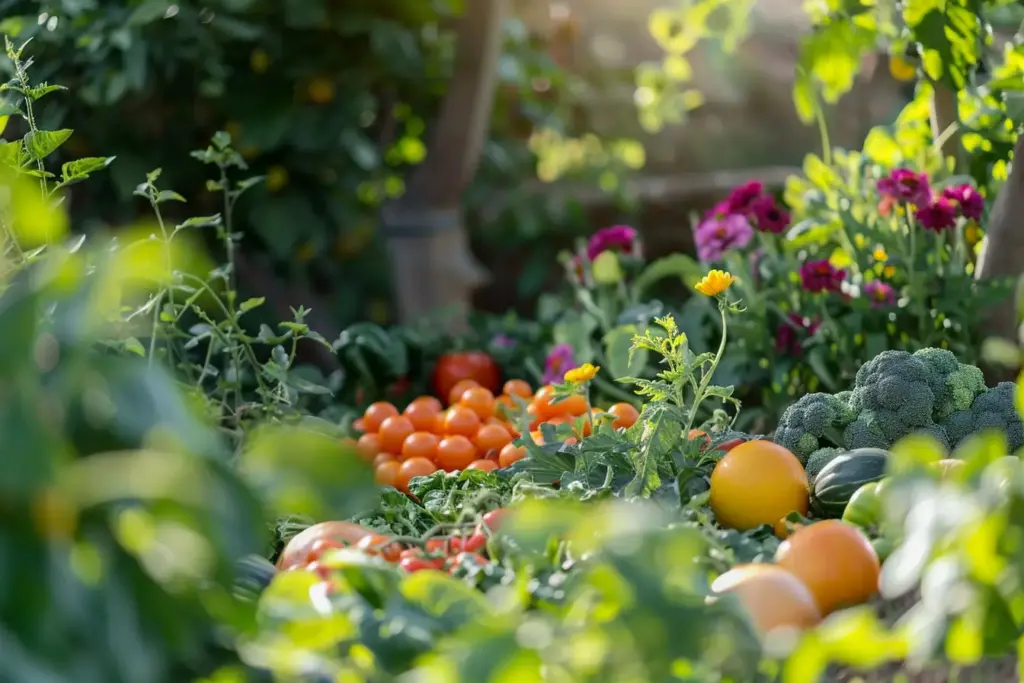
Fruits and Vegetables: The Foundation of a Vegan Diet
Nutrient-Dense Choices
A vegan food list for beginners should prioritize fruits and vegetables due to their high nutrient density and health benefits. These foods are packed with essential vitamins, minerals, and antioxidants.
Essential Fruits for Beginners
Incorporating a variety of fruits into your diet ensures you get a range of nutrients. Some must-haves include:
- Berries: Blueberries, strawberries, raspberries – rich in antioxidants
- Citrus Fruits: Oranges, grapefruits, lemons – high in vitamin C
- Bananas: Excellent source of potassium
- Apples: Great for fiber and vitamin C
- Avocados: High in healthy fats and fiber
Essential Vegetables for Beginners
Vegetables should make up a significant portion of a vegan diet. Here are some essential options:
- Leafy Greens: Spinach, kale, collard greens – high in iron and calcium
- Cruciferous Vegetables: Broccoli, cauliflower, Brussels sprouts – rich in vitamins C and K
- Root Vegetables: Carrots, sweet potatoes, beets – excellent sources of beta-carotene and fiber
- Peppers: Bell peppers, chili peppers – high in vitamin C and antioxidants
- Tomatoes: Packed with lycopene, an antioxidant
Seasonal Produce
Eating seasonal produce ensures freshness, better taste, and often lower costs. It also supports local farming. Here are some tips:
- Spring: Asparagus, peas, radishes
- Summer: Berries, tomatoes, cucumbers, zucchini
- Fall: Pumpkins, squash, apples, pears
- Winter: Citrus fruits, root vegetables, kale
Incorporating Fruits and Vegetables into Your Diet
Adding more fruits and vegetables to your diet can be simple and enjoyable:
- Smoothies: Blend fruits and greens for a nutrient-packed breakfast or snack.
- Salads: Mix various vegetables and fruits for colorful and tasty salads.
- Stir-Fries: Combine your favorite vegetables with tofu or tempeh for a quick meal.
- Roasted Veggies: Roast root vegetables with olive oil and herbs for a delicious side dish.
- Snacks: Keep cut-up fruits and veggies handy for easy snacking.
Tips for Storage and Preparation
Proper storage and preparation can help retain the nutrients in fruits and vegetables:
- Refrigerate: Store most fruits and vegetables in the refrigerator to keep them fresh longer.
- Wash Before Eating: Always wash produce thoroughly to remove pesticides and dirt.
- Cut Just Before Eating: Cutting fruits and vegetables just before consumption helps retain their nutrients.
- Steaming and Roasting: These cooking methods preserve more nutrients than boiling.
Organic vs. Conventional
Choosing between organic and conventional produce depends on personal preference and budget. While organic produce is grown without synthetic pesticides and fertilizers, traditional produce is generally more affordable. Washing and peeling can help reduce pesticide residues on conventional fruits and vegetables.
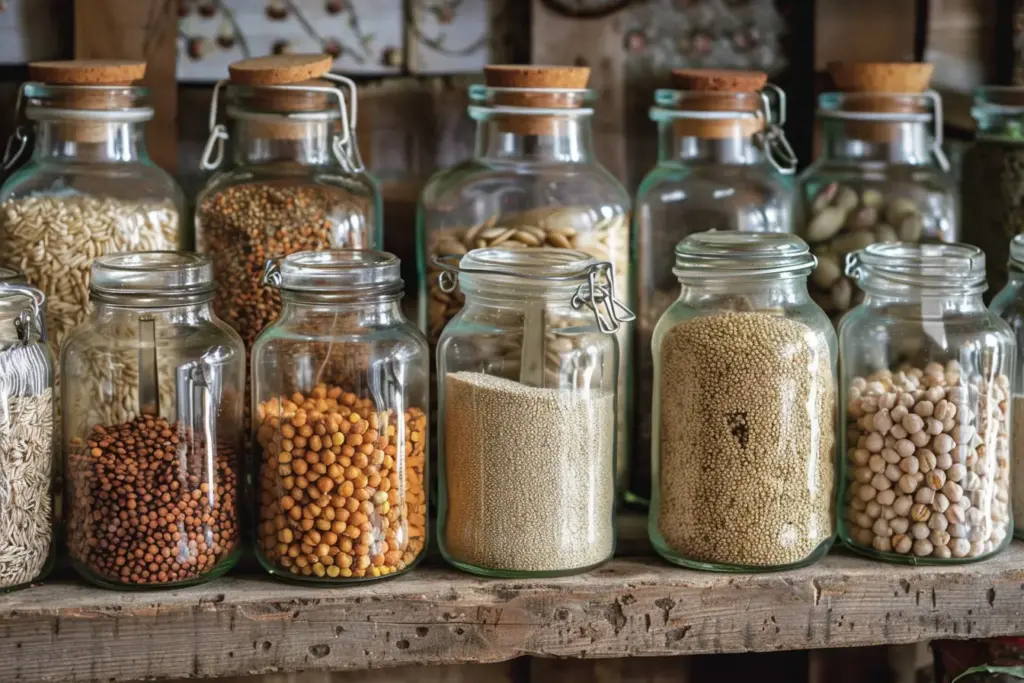
Whole Grains and Legumes: Key Sources of Protein
Importance of Whole Grains
Whole grains are a staple in a vegan food list for beginners due to their high fiber content and essential nutrients. They provide sustained energy and are a good source of protein.
Essential Whole Grains
Incorporate a variety of whole grains to ensure a balanced diet. Key options include:
- Quinoa: A complete protein containing all nine essential amino acids.
- Brown Rice: High in fiber and magnesium.
- Oats: Great for breakfast, high in fiber and iron.
- Barley: Rich in fiber and good for heart health.
- Farro: Ancient grain high in protein and fiber.
Benefits of Legumes
Legumes are another crucial component of a vegan diet. They provide protein, fiber, and essential nutrients. They are versatile and can be used in various dishes.
Essential Legumes
Include these legumes in your diet to meet your protein needs:
- Lentils: High in protein and iron, perfect for soups and stews.
- Chickpeas: Versatile, great for salads, stews, and making hummus.
- Black Beans: High in protein and fiber, ideal for tacos, salads, and soups.
- Kidney Beans: Excellent for chili and stews, high in protein and fiber.
- Peas: Good source of protein and fiber, can be used in soups and salads.
Cooking and Preparing Whole Grains
Knowing how to cook and prepare whole grains can make them more enjoyable and easier to incorporate into your meals:
- Rinsing: Rinse grains like quinoa and rice before cooking to remove excess starch.
- Toasting: Toast grains in a dry skillet before cooking to enhance their flavor.
- Cooking Ratios: Use the correct water-to-grain ratio for perfect texture (e.g., 2:1 for rice, 2.5:1 for quinoa).
- Bulk Cooking: Cook grains in bulk and store them in the fridge for quick meal prep.
Cooking and Preparing Legumes
Proper preparation of legumes is essential for better digestion and nutrient absorption:
- Soaking: Soak beans overnight to reduce cooking time and improve digestibility.
- Rinsing: Rinse canned legumes to reduce sodium content.
- Cooking: Use a pressure cooker or stovetop to cook legumes until tender.
- Seasoning: Season with herbs and spices to enhance flavor without adding excess salt.
Easy Recipes with Whole Grains and Legumes
Incorporating whole grains and legumes into your diet can be simple and delicious:
- Quinoa Salad: Combine cooked quinoa with vegetables, beans, and a light vinaigrette.
- Lentil Soup: A hearty soup with lentils, vegetables, and spices.
- Chickpea Stew: A savory stew with chickpeas, tomatoes, and greens.
- Black Bean Tacos: Fill tacos with seasoned black beans, veggies, and avocado.
- Farro Pilaf: For a nutritious side dish, cook Farro with vegetables and broth.
Nutritional Benefits
Whole grains and legumes are packed with nutrients that support overall health:
- Fiber: Aids in digestion and helps maintain a healthy weight.
- Protein: Essential for muscle repair and growth.
- Iron: Crucial for oxygen transport in the blood.
- Magnesium: Supports muscle and nerve function.
By including a variety of whole grains and legumes in your vegan food list for beginners, you can ensure a balanced, nutritious diet that supports your health and well-being.
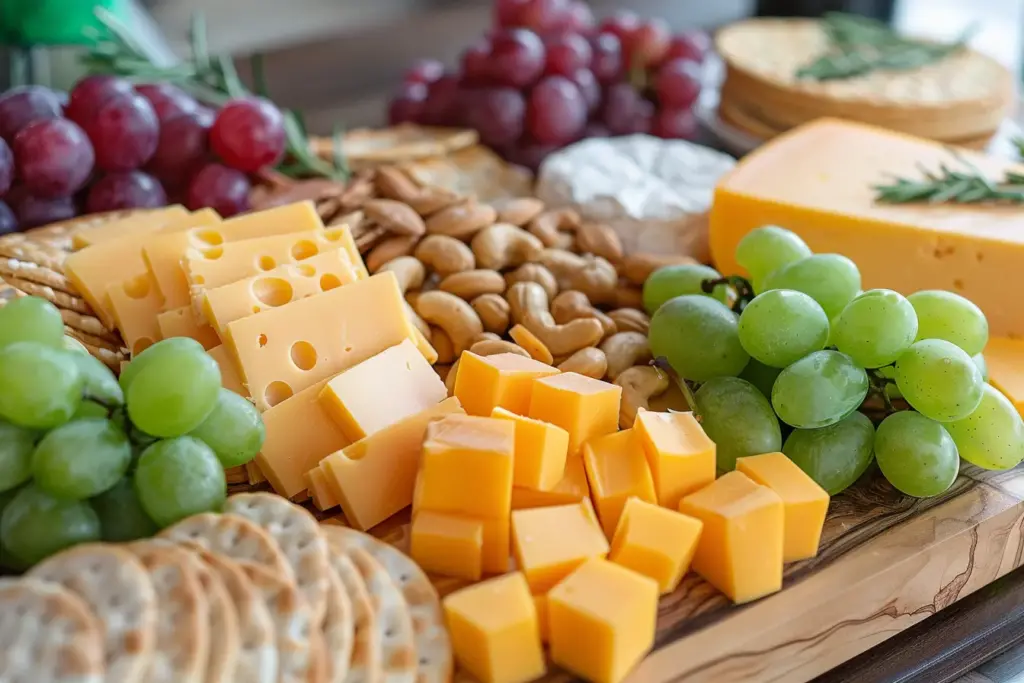
Dairy Alternatives: Milk, Cheese, and Yogurt
Why Choose Dairy Alternatives?
Finding suitable dairy alternatives is essential for those starting on a vegan food list for beginners. These options provide the familiar textures and flavors of dairy products without the use of animal products, ensuring a seamless transition to a vegan diet.
Plant-Based Milk Options
There is a wide variety of plant-based milks available, each with unique flavors and nutritional profiles:
- Almond Milk: Low in calories, with a mild, nutty flavor.
- Soy Milk: High in protein, often fortified with calcium and vitamin D.
- Oat Milk: Creamy texture, rich in fiber and beta-glucans, beneficial for heart health.
- Coconut Milk: Rich and creamy, adds a distinct coconut flavor.
- Rice Milk: Mild taste, suitable for those with nut allergies.
Choosing the Right Plant-Based Milk
When selecting plant-based milk, consider these factors:
- Nutritional Content: Look for milks fortified with calcium, vitamin D, and B12.
- Flavor: Choose a flavor that complements your recipes and taste preferences.
- Consistency: Some milks are creamier (e.g., oat milk) and better suited for coffee or baking.
Plant-Based Cheese Alternatives
Vegan cheeses have come a long way in terms of taste and texture. Popular options include:
- Cashew Cheese: Made from blended cashews, it’s creamy and versatile.
- Almond Cheese: Has a mild flavor and is excellent for slicing and melting.
- Soy Cheese: Often used as a direct replacement for traditional cheese, melts well.
- Nutritional Yeast: Adds a cheesy flavor to dishes, rich in B12 when fortified.
Using Vegan Cheese
Incorporate vegan cheese into your meals in various ways:
- Pizza: Use shredded vegan cheese as a topping.
- Pasta: Stir in cashew cheese for a creamy sauce.
- Sandwiches: Slice almond cheese for a flavorful addition.
Plant-Based Yogurt Alternatives
Vegan yogurts are made from a variety of plant milks and offer similar textures and flavors to dairy yogurt:
- Soy Yogurt: High in protein, similar in texture to traditional yogurt.
- Coconut Yogurt: Rich and creamy with a tropical flavor.
- Almond Yogurt: Light and nutty, suitable for smoothies and parfaits.
- Oat Yogurt: Creamy, with a mild taste, often fortified with beneficial nutrients.
Nutritional Benefits of Dairy Alternatives
Plant-based dairy alternatives can offer several health benefits:
- Lower in Saturated Fats: Typically have less saturated fat compared to dairy products.
- Cholesterol-Free: No cholesterol, which is beneficial for heart health.
- Fortified Nutrients: Often enriched with essential vitamins and minerals like calcium, vitamin D, and B12.
Homemade Dairy Alternatives
For those interested in making their own dairy alternatives, it can be simple and cost-effective:
- Almond Milk: Blend soaked almonds with water, then strain.
- Cashew Cheese: Blend soaked cashews with nutritional yeast, lemon juice, and water until creamy.
- Coconut Yogurt: Mix coconut milk with probiotic capsules and let it ferment.
Tips for Transitioning to Dairy Alternatives
Here are some tips for incorporating dairy alternatives into your vegan food list for beginners:
- Experiment: Try different brands and types to find your favorites.
- Read Labels: Look for added sugars and opt for unsweetened varieties when possible.
- Use in Recipes: Substitute plant-based milks, cheeses, and yogurts in your favorite recipes to see what works best.
By exploring and incorporating these dairy alternatives into your diet, you can enjoy the familiar flavors and textures of dairy products while adhering to a vegan lifestyle.

Meat Substitutes: Plant-Based Proteins
The Role of Meat Substitutes
Meat substitutes play a crucial role in compiling a vegan food list for beginners. They offer familiar textures and flavors, smoothing the transition to a plant-based diet. These substitutes are typically protein-rich and can be used in various dishes.
Tofu
What is Tofu?
Tofu, also known as bean curd, is made from soybeans and is a versatile meat substitute. It absorbs flavors well and can be used in various dishes.
Types of Tofu
- Silken Tofu: Soft and creamy, great for smoothies, soups, and desserts.
- Firm Tofu: Ideal for stir-fries, grilling, and baking.
- Extra Firm Tofu: Holds its shape well, perfect for frying and sautéing.
Tempeh
What is Tempeh?
Tempeh is a fermented soy product with a firm texture and a nutty flavor. It is higher in protein and fiber compared to tofu.
How to Use Tempeh
- Marinate and Grill: Absorbs marinades well and can be grilled for a smoky flavor.
- Crumble for Tacos: Crumble and sauté with spices for a ground meat substitute.
- Stir-Fries: Slice and add to vegetable stir-fries for extra protein.
Seitan
What is Seitan?
Seitan, also known as wheat gluten, is a high-protein meat substitute with a chewy texture similar to meat. It’s made from gluten, the protein found in wheat.
How to Use Seitan
- Stir-Fries and Stews: Absorbs flavors well, making it great for savory dishes.
- Sandwiches: Slice thinly for a deli-style sandwich.
- Grill or Fry: Can be grilled or fried to mimic meat dishes.
Jackfruit
What is Jackfruit?
Jackfruit is a tropical fruit that, when unripe, has a texture similar to shredded meat. It’s low in protein but high in fiber.
How to Use Jackfruit
- Pulled Jackfruit: Perfect for vegan pulled “pork” sandwiches or tacos.
- Curries and Stews: Adds a meaty texture to curries and stews.
- BBQ Jackfruit: Mix with BBQ sauce for a savory dish.
Legume-Based Burgers and Sausages
Popular Options
Many legume-based meat substitutes, such as black bean burgers and lentil sausages, are available. These products are often fortified with additional nutrients to mimic the nutritional profile of meat.
How to Use Legume-Based Products
- Burgers: Cook on the grill or stovetop for a delicious plant-based burger.
- Sausages: Grill or sauté for sandwiches, pasta dishes, or as a breakfast item.
- Meatballs: Form into meatballs for spaghetti or subs.
Beyond Meat and Impossible Foods
Plant-Based Meat Alternatives
Brands like Beyond Meat and Impossible Foods offer meat substitutes that closely mimic the taste and texture of real meat. These products are made from various plant-based ingredients and designed to be used just like traditional meat.
How to Use These Products
- Burgers: Cook on the grill or stovetop just like traditional burgers.
- Ground Meat: Use in recipes calling for ground beef, such as tacos, meat sauces, and casseroles.
- Sausages and Nuggets: Cook as you would their meat counterparts.
Nutritional Benefits
Plant-based meat substitutes can offer several health benefits:
- Lower in Saturated Fat: Typically, less saturated fat than animal meat.
- No Cholesterol: Plant-based proteins are cholesterol-free.
- Rich in Fiber: Many substitutes contain more fiber than meat.
Cooking Tips for Meat Substitutes
Here are some tips for making the most of meat substitutes in your vegan food list for beginners:
- Marinating: Marinate tofu, tempeh, and seitan to enhance their flavors.
- Seasoning: Use bold spices and herbs to add depth to your dishes.
- Cooking Techniques: Experiment with different cooking methods, such as grilling, baking, and frying, to find what you like best.
Incorporating these meat substitutes into your diet can help you enjoy the flavors and textures of meat while following a vegan lifestyle.
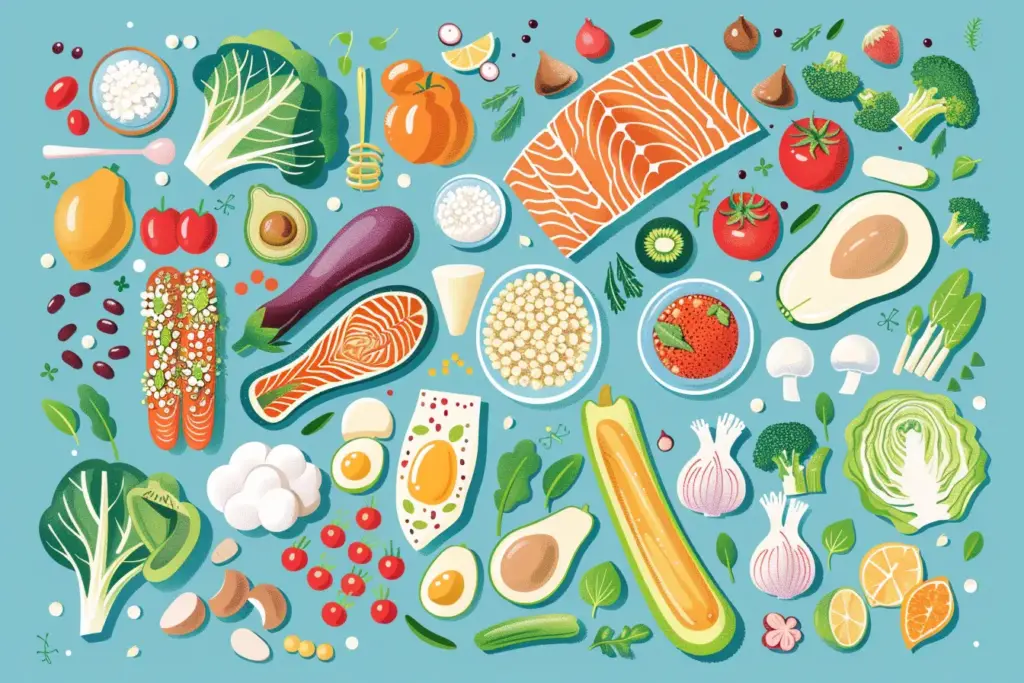
Snacks and Convenience Foods for New Vegans
Importance of Convenient Options
For those starting on a vegan food list for beginners, having easy and convenient snack options is crucial. These foods can help you stick to your diet, especially when you’re on the go or short on time.
Healthy Vegan Snacks
Incorporate these healthy snacks into your diet for quick and nutritious options:
- Fresh Fruit: Apples, bananas, berries – easy to pack and eat on the go.
- Nuts and Seeds: Almonds, walnuts, sunflower seeds – high in protein and healthy fats.
- Vegetable Sticks: Carrots, celery, bell peppers – pair with hummus for extra flavor.
- Rice Cakes: Top with avocado or nut butter for a filling snack.
Store-Bought Vegan Snacks
Many store-bought snacks are now vegan-friendly, making it easier to find quick options:
- Vegan Protein Bars: Look for bars with plant-based proteins like soy or pea protein.
- Popcorn: Plain or lightly seasoned varieties are often vegan.
- Dark Chocolate: Choose dairy-free options for a sweet treat.
- Vegan Chips: Many brands offer vegetables, beans, or grains chips.
Homemade Vegan Snacks
Preparing your snacks at home can be cost-effective and healthier:
- Energy Balls: Made with dates, nuts, and seeds – easy to customize with your favorite ingredients.
- Trail Mix: Combine nuts, seeds, dried fruit, and dark chocolate for a satisfying mix.
- Baked Kale Chips: A crunchy and nutritious alternative to traditional chips.
- Smoothies: Blend fruits, greens, and plant-based milk for a quick and nutritious drink.
Easy Vegan Meals
Convenience foods aren’t just for snacking; they can also make meal prep easier:
- Frozen Veggie Burgers: Quick to cook and great for a speedy meal.
- Pre-Cooked Grains: Microwaveable quinoa or rice can save time.
- Canned Beans: Ready to use in salads, stews, or as a side dish.
- Frozen Vegetables: Pre-cut and ready to cook, making meal prep faster.
Reading Labels
When choosing store-bought snacks and convenience foods, it’s important to read labels to ensure they are vegan:
- Check for Dairy and Eggs: Look for common non-vegan ingredients like milk powder, whey, and egg whites.
- Look for Vegan Certifications: Some products are labeled vegan, making them easier to identify.
- Be Aware of Hidden Ingredients: Ingredients like gelatin, casein, and certain food colorings are not vegan.
On-the-Go Snacks
Having portable snacks can help you stay on track with your vegan diet:
- Fruit and Nut Bars: Compact and easy to carry.
- Dried Fruit: A sweet and convenient option.
- Vegan Jerky: Made from soy, mushrooms, or other plant-based ingredients.
- Nut Butter Packs: Single-serving packets of almond or peanut butter.
Budget-Friendly Options
Eating vegan doesn’t have to be expensive. Here are some budget-friendly snack ideas:
- Homemade Hummus: Blend chickpeas, tahini, lemon juice, and garlic – pair with veggie sticks or pita bread.
- Air-Popped Popcorn: A healthy and inexpensive snack.
- DIY Trail Mix: Buy nuts, seeds, and dried fruit in bulk and mix your own.
- Banana Nice Cream: Blend frozen bananas for a creamy, ice-cream-like treat.
Quick Meal Ideas
For quick and easy meals, consider these options:
- Wraps and Sandwiches: Fill with hummus, veggies, and plant-based proteins.
- Stir-Fries: Use frozen vegetables and pre-cooked grains for a fast meal.
- Salads: Pre-washed greens and canned beans make for a speedy salad.
- Soup and Bread: Canned or boxed vegan soups paired with whole-grain bread.
Having a variety of snacks and convenience foods on your vegan food list can make the transition smoother and more enjoyable, ensuring you always have a delicious and nutritious option.
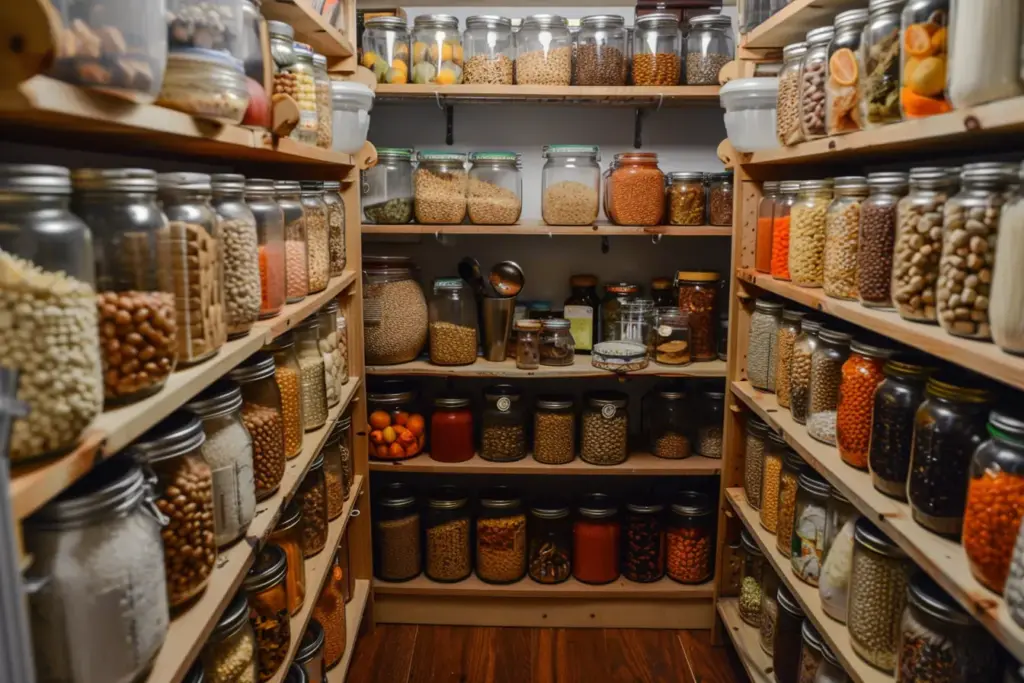
Building a Balanced Vegan Food List for Beginners
Understanding a Balanced Vegan Diet
Creating a balanced vegan food list for beginners is essential to meet all nutritional needs. A well-rounded diet includes a variety of plant-based foods that provide necessary nutrients.
Stocking Your Pantry
A well-stocked pantry is the foundation of a balanced vegan diet. Here are some essentials to include:
- Grains: Quinoa, brown rice, oats, whole wheat pasta
- Legumes: Lentils, chickpeas, black beans, kidney beans
- Nuts and Seeds: Almonds, walnuts, chia seeds, flaxseeds
- Flours: Whole wheat flour, almond flour, chickpea flour
Filling Your Fridge
Keeping your fridge stocked with fresh produce and other essentials is vital:
- Fresh Vegetables: Leafy greens, bell peppers, broccoli, carrots, zucchini
- Fresh Fruits: Berries, apples, bananas, citrus fruits, avocados
- Dairy Alternatives: Almond milk, soy yogurt, vegan cheese
- Tofu and Tempeh: Protein-rich and versatile for many recipes
Filling Your Freezer
A well-stocked freezer ensures you always have quick meal options available:
- Frozen Fruits and Vegetables: Berries, spinach, peas, mixed vegetables
- Frozen Grains: Pre-cooked quinoa, brown rice
- Vegan Burgers and Sausages: Convenient for quick meals
- Homemade Meals: Soups, stews, and casseroles portioned for easy reheating
Meal Planning Tips
Planning your meals can help ensure a balanced diet and make grocery shopping easier:
- Weekly Meal Plan: Outline your meals, including breakfast, lunch, dinner, and snacks.
- Batch Cooking: Prepare large batches of grains, beans, and vegetables to use throughout the week.
- Versatile Recipes: Choose recipes that are easily adapted with different ingredients to keep meals interesting.
Essential Kitchen Tools
Having the right tools can make preparing vegan meals easier and more enjoyable:
- High-Quality Blender: Essential for smoothies, soups, and sauces
- Food Processor: Great for making dips, spreads, and dough
- Sharp Knives: Crucial for efficiently chopping fruits and vegetables
- Pressure Cooker or Instant Pot: Speeds up cooking time for grains and legumes
Sample Grocery List
Here’s a sample grocery list to get you started on your vegan food list for beginners:
- Vegetables: Spinach, kale, bell peppers, carrots, sweet potatoes
- Fruits: Bananas, apples, oranges, berries, avocados
- Grains: Quinoa, brown rice, oats, whole wheat bread
- Legumes: Lentils, chickpeas, black beans, tofu
- Nuts and Seeds: Almonds, walnuts, chia seeds, sunflower seeds
- Dairy Alternatives: Almond milk, soy yogurt, vegan cheese
- Pantry Staples: Olive oil, coconut oil, tamari, nutritional yeast
- Spices and Herbs: Cumin, turmeric, basil, oregano, paprika
Nutritional Balance
Ensure your vegan food list includes a variety of foods to cover all nutritional bases:
- Protein: Beans, lentils, tofu, tempeh, quinoa, nuts, seeds
- Iron: Leafy greens, lentils, chickpeas, fortified cereals
- Calcium: Fortified plant milks, tofu, almonds, leafy greens
- Omega-3 Fatty Acids: Flaxseeds, chia seeds, walnuts, hemp seeds
- Vitamin B12: Fortified foods, nutritional yeast, supplements
Tips for Success
Here are some additional tips to help you build and maintain a balanced vegan diet:
- Experiment with New Recipes: Try new dishes to keep your meals exciting and diverse.
- Stay Hydrated: Drink plenty of water throughout the day.
- Listen to Your Body: Pay attention to how different foods make you feel and adjust your diet as needed.
- Seek Support: Join vegan communities for support, recipe ideas, and motivation.
By following this guide and creating a comprehensive vegan food list for beginners, you can ensure a balanced, nutritious, and enjoyable plant-based diet.

